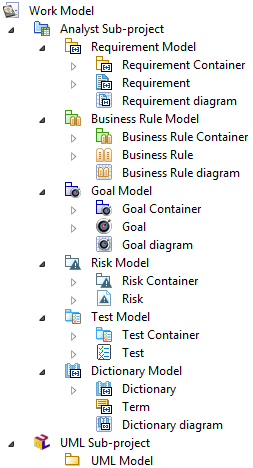Projects, work models and sub-projects
Modelio project 
In Modelio, a project is similar to a document in Word: you open it, modify its contents and save the changes (or not) before closing it. From the end user point of view, the project is the unit of work and persistence of his/her contributions. Once opened, the project appears to the end user as a unique model, composed of many model elements, usually organized into packages and other high level containers. The "Save" operation also appears to be applied to the unique model proposed by the opened project. However, behind the scenes, the manipulated model elements may be provided by several model fragments and their physical repositories, and Modelio is in charge of managing these repositories transparently as a unique model.
Work models 
Work models are groups of higher level model elements. Model designers attribute logical consistency to work models, but their primary function is to autonomously store a part of a model. A model element from a given work model can be linked to model elements from another work model, but this link must be a simple reference, and not a containment or composition link.
A model element really belongs to a work model, but its ownership is not definitive. It can be moved to another work model, according to the organizational needs of the designers. Work models are tightly coupled with repositories. Modelio supports several repository technologies (Local, SVN, Model Components…). Each technology has specific characteristics that must be understood when choosing one of them for a particular repository.
Analyst sub-project 
Since version 3.6, Modelio supports several kind of sub-projects (UML, MDA, ArchiMate, Analyst…). These sub-projects can coexist within the same work model. An Analyst sub-project therefore organizes all Analysts elements created under a work model.
Analyst models
Under the Analyst sub-project, the different Analyst concepts are organized into different models :  Requirements,
Requirements,  Goals,
Goals,  Business rules,
Business rules,  Dictionaries,
Dictionaries,  Risks and
Risks and  Tests.
Tests.
